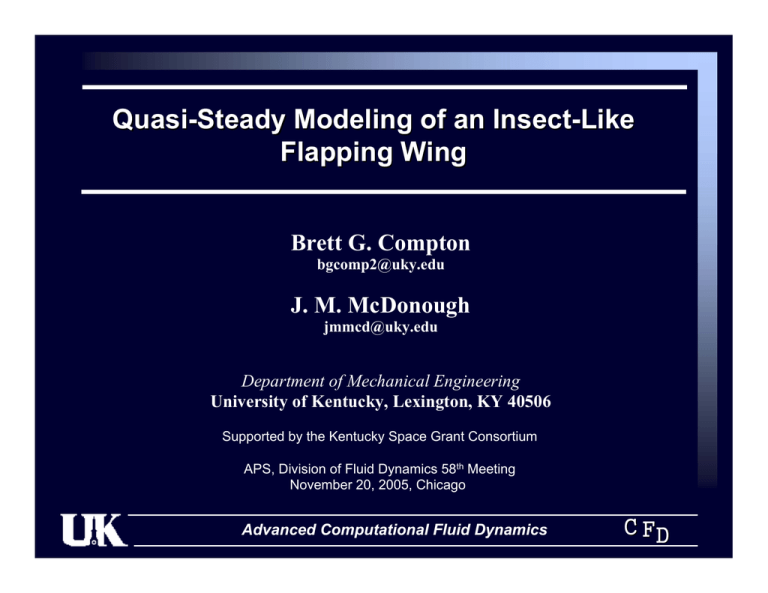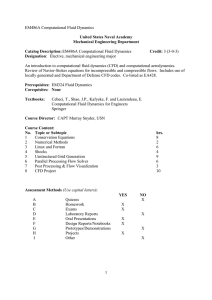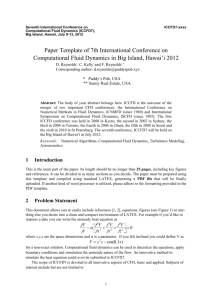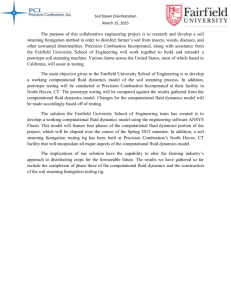Quasi - Steady Modeling of an Insect Like
advertisement

Quasi-Steady Modeling of an Insect-Like Flapping Wing Brett G. Compton bgcomp2@uky.edu J. M. McDonough jmmcd@uky.edu Department of Mechanical Engineering University of Kentucky, Lexington, KY 40506 Supported by the Kentucky Space Grant Consortium APS, Division of Fluid Dynamics 58th Meeting November 20, 2005, Chicago Advanced Computational Fluid Dynamics C FD Previous Work • • • • • • • • • Munk (NACA Report, 1925) Weis-Fogh (J. Exp. Biol., 1973) Maxworthy (J. Fluid Mech., 1979) Ellington (Phil. Trans. R. Soc. Lond, 1984) Dickinson (J. Exp. Biol., 1994) Wang (J. Exp. Biol. 2003) Sane (J. Exp. Biol., 2003) Miller and Peskin (J. Exp. Biol., 2004) Many others Advanced Computational Fluid Dynamics C FD Physical Problem and Purpose • Insect flight is both a biological wonder and an aerodynamic enigma. • The forces acting on flapping wings are highly unsteady, leading to higher lift forces from novel lift-generating phenomena. • We want to replicate and explore these curious aerodynamic phenomena. Advanced Computational Fluid Dynamics C FD Our Approach • We use a quasi-unsteady approach. Transient calculations are made at various virtual wing orientations throughout the half-stroke. – The wing remains fixed and input conditions are changed to account for wing rotation. – A linear velocity profile along the span is employed to mimic flapping about the base of the wing. – The time steps are chosen such that between each virtual wing orientation realistic physical time passes. No steady-state calculations are made. Advanced Computational Fluid Dynamics C FD Our Approach (cont.) Step 1 Step 2 U U Or… Step 1 Step 2 U U Advanced Computational Fluid Dynamics C FD Our Approach (cont.) • Advantages – Simplicity – Accessible Software – Transient Calculations at Variable Flight Regimes – Laminar/Turbulence Comparison • Disadvantages – Limiting Grid Setup – Not Quite Realistic • Rotational Acceleration not accounted for • “Ground Effects” Inherent in Model • Virtual Mass not accounted for Advanced Computational Fluid Dynamics C FD Our Approach (cont.) Domain seen from the leading edge Looking down the span of the wing Advanced Computational Fluid Dynamics C FD Problem Setup • Approximate Bumblebee Kinematics (Dudley and Ellington, J. Exp. Biol. 1990a,b) – R = 1.4 cm – c = 0.4 cm – wing thickness = 0.01 cm – AR = 7 – n = 150 Hz – Φ = 2 rad (115°) – αm = 35° – Ut = 2ΦnR = 8.4 m/s – Re = cUt/ν = 2333 • Grid – Cubic domain 7.5 chord lengths per side – ~350,000 grid points – Wing placed 17 grid points and ¼ chord lengths from velocity inlet Advanced Computational Fluid Dynamics C FD Results – Spiral LEV Views in each coordinate direction plus Pictorial with vortex core. Physical step 10 of 24. Advanced Computational Fluid Dynamics C FD Results – Force Coefficients Average Forces and Coefficients: Force Coefficient Time Series cd-laminar cd-LES cl-laminar cl-LES 1 force coefficient 0.9 0.8 0.7 0.6 0.5 0.4 0.3 0.2 0.1 0 -0.1 0 0.1 0.2 0.3 0.4 0.5 0.6 fraction of half-stroke 0.7 0.8 0.9 1 Cl,avg,lam: 0.593 Cl,avg,LES: 0.618 Fl,avg,lam: 0.00296 N Fl,avg,LES: 0.00309 N Cd,avg,lam: 0.492 Cd,avg,LES: 0.495 Fd,avg,lam: 0.00246 N Fd,avg,LES: 0.00248 N Average Bee weight: 0.001717 N Advanced Computational Fluid Dynamics C FD Results – Quasi-Steady? In our model the Lift and Drag forces do not stabilize quickly enough for the quasi-steady model to be accurate. Extended Calculations for Coefficient of Lift at Various Wing Orientations force coefficients α = 44.27º α = 39.19º α = 35.82º 1 0.9 0.8 0.7 0.6 0.5 0.4 0.3 0.2 0.1 0 0.0 0.1 0.2 0.3 0.4 0.5 0.6 0.7 0.8 0.9 1.0 fraction of half-stroke Advanced Computational Fluid Dynamics C FD Conclusions • The spiral leading edge vortex was successfully replicated with this highly simplified model and the force coefficient time series roughly resemble results from previous experiments, however… • A better model is needed. The next step is to use a research code that will allow more flexibility in the problem setup, as well as allow imbedded boundary treatment on the wing. Advanced Computational Fluid Dynamics C FD



